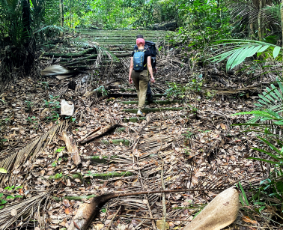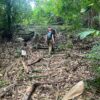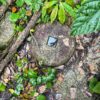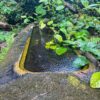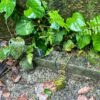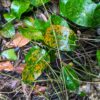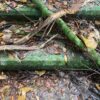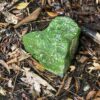Yes, we crawled with a party of three through a tropical jungle and back to visit the ruins of a destroyed Japanese shrine from the Second World War.
(Enjoy more images from that trip over at Flickr!)
We have a friend in Singapore who happens to excel at managing expectations:
“Any plans for tomorrow yet? No? Well, how about this. There’s a path through the jungle at the MacRichie Reservoir that leads to a destroyed Japanese shrine, with everything you can expect from a tropical jungle including wildlife and mosquitoes and mud traps and sudden torrential downpours; parts of the path I once took will be overgrown by now or blocked by fallen trees so we might never reach our goal; there’s a slight but non-zero chance to be caught by rangers; and when we can’t get out before nightfall we’re in deep shit. How does that sound to you?”
“Awesome. We’re in.”
Hell, it was exactly as advertised!
We had some support, of course. Our friend still had his GPS data from the trip he took with a group of friends a few years ago. Also, other parties had fastened trail markers around tree branches, some of them ancient, some more recent. Nevertheless, we couldn’t just straight up follow any of that, neither the GPS line nor the markers, which would have been hard enough already. Jungles change, and fallen trees in particular blocked any previously charted path time and again. Thus, we had to backtrack frequently and take substantial detours to find our own fresh paths through the jungle, without ever losing the markers and/or GPS line completely.
But yes! We found the shrine, and we didn’t get caught by rangers or nibbled on by wildlife, and we got out of the jungle and climbed back on the reservoir’s boardwalk trail just in time with the falling dusk.
By then, however, rain had set in for good and become so relentless that we couldn’t see straight, and we were muddy, bloody, and soaked from head to toe, with our waterproof backpacks as the only exception. We cleared the mud and washed out our scratches with water from a nearby ranger station’s drinking fountain. But that was all we could do, and getting home in our condition posed a major problem. No Grab driver (the local version of Uber) would let us near their car, not to speak of into. Public transportation looked like an option, but not really. It was about thirty minutes on the bus for starters, then another thirty minutes on two MRT subway lines. Which might not sound so bad, but Singapore’s busses and subway stations and trains are so excessively AC’ed that we could place safe bets on catching severe colds, soaked as we were, if not worse. Thus, we had to call in the chopper for immediate evac call Mom to pick us up, with a special directive to bring three blankets so we wouldn’t mess up her car!
For her own benefit, naturally, Mom wasn’t in the know; for her, we’d just hiked along the reservoir’s regular boardwalk trails and then been caught by the rain. Which neither accounted for our spectacular exhaustion levels nor our numerous bites and concussions and scratches, with my left arm looking pretty messed-up in particular. (From our little party, my scratches were the worst by far overall—but to balance that out, my repellant had done a terrific job and I hadn’t caught one single mosquito bite!) We’ll see how our flimsy explanations will hold up.
The evening went along with taking lengthy showers, pulling thorns out of our legs and hands, and applying antiseptics to our scratches. After that, we went along with Mom for a terrific dinner at Bishan Junction 8’s Dian Xiao Er. That was great! And the ice-cold Tiger beer that accompanied it was damn good as well.
As for the Shōnan Jinja, there’s a lot of history involved. After the Japanese Imperial Army had conquered Singapore from the British in the Second World War, they committed a string of civilian, POW, and hospital massacres and other atrocities and then cleared part of the jungle at the reservoir to built a shrine, complete with an access bridge across the lake. When Japan surrendered in 1945, the Japanese troops blew up the shrine before they retreated. (Or maybe the British did it—none of the sources I was able to check so far are remotely reliable.)
Between then and now, the bridge was dismantled, and the jungle reclaimed the ruins of the shrine. All that’s left today is a bunch of stairs and a rainwater-filled chōzubachi ablution basin; from the chōzuya pavilion it was part of, only the concrete foundations for its support posts remained.
That’s it. Plus, and I’m tempted to say of course, we found an empty sake bottle next to the chōzubachi. My guess is Japanese nationalists found their way to this place and indulged in their usual nationalist fantasies.
There’s a lot of nonsense written about the shrine at the English Wikipedia site, all lifted from trash sources. However, the Japanese Wikipedia site confirms that the shrine was designated as a historical site by Singapore’s National Heritage Board in 2002. But then they continued to leave it to rot in the jungle, inaccessible for anyone in their right mind. Pretty clever two-way solution, I guess, to get rid of potential problems a shrine with that history at this place could cause!
- Not Your Lunch
- Shōnan Jinja
- Chōzuya
- Chōzubachi
- Chōzubachi
- Shōnan Jinja
- Shōnan Jinja
- Shōnan Jinja
If you have something valuable to add or some interesting point to discuss, I’ll be looking forward to meeting you at Mastodon!
